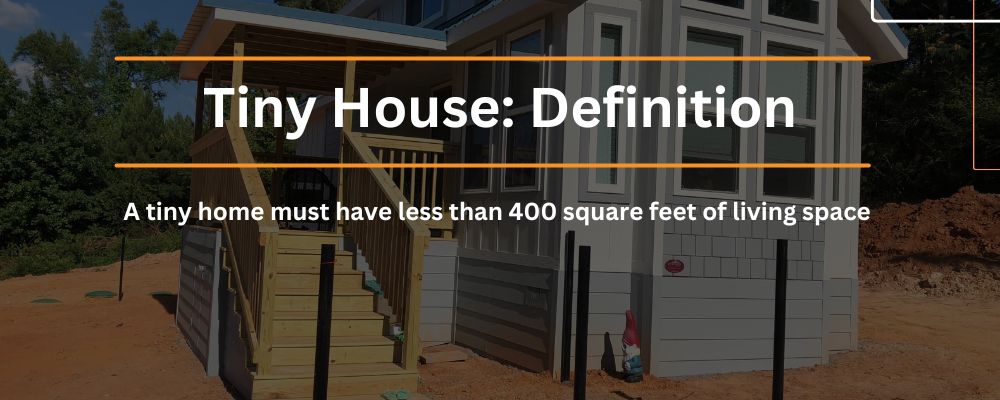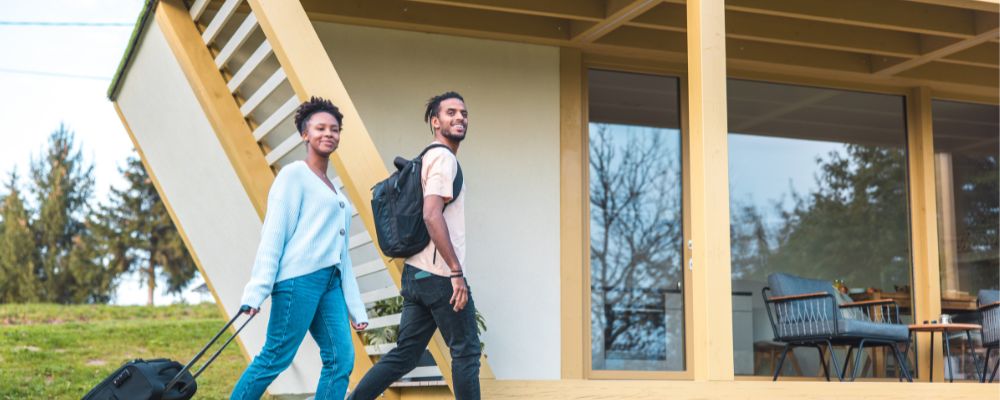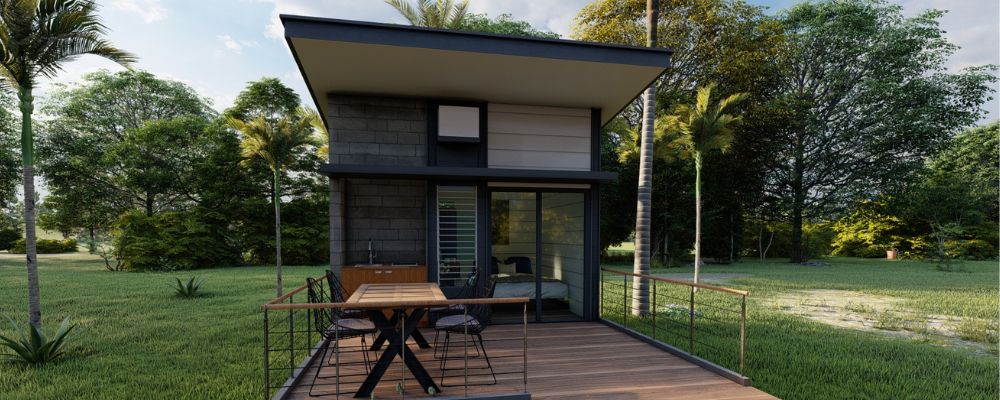Tiny homes are a growing trend among those who want an affordable, low-maintenance alternative to traditional houses. They are attractive for those who want to reduce their carbon footprint, live off the grid, or simply need a more affordable path to homeownership.
While tiny houses certainly appeal to a specific type of homeowner, they also have drawbacks, especially regarding appreciation. So, if you are an investor thinking about cashing in on the tiny house movement, here is everything you need to know.
Table of Contents
What Is A Tiny House?

A tiny home must have less than 400 square feet of living space.
Tiny homes are residential dwellings that offer a reduction in living space in exchange for flexibility, affordability, and environmental sustainability. Like traditional houses, they can come in a wide variety of different forms and sizes. However, according to the International Residential Code, a tiny home must have less than 400 square feet of living space.
Many tiny homes are mobile platforms with wheels that support a nomadic lifestyle. They are also sometimes made out of old shipping containers or offered as modular homes that can be customized to the owner’s liking and shipped to the installation site. So, they are perfect for those looking to live in the wilderness or find a more cost-effective and eco-friendly alternative to traditional homes.
How Much Smaller Is It Than a Normal House?
Tiny homes range in size from about 100 – 400 square feet. The average single-family home is anywhere from 1,200–2,500 square feet, with the average size in the US being 2,300. Therefore, square footage of the living area inside the dwelling is typically about 20% or lower inside a tiny home, compared to residential homes. In comparison, the average size of an apartment in the US is about 800 square feet.
So, tiny homes are about half the size of the average condo (or less).
Do Tiny Homes Appreciate in Value?
- Tiny homes can appreciate in value, but not consistently or predictably.
- Tiny homes on wheels depreciate like recreational vehicles and mobile homes.
- Modular tiny homes may appreciate more than mobile ones but less than traditional houses.
- Quality construction and permanence on a real foundation improve appreciation chances.
- Tiny homes can face stigma, impacting long-term value.
- Location significantly affects tiny home appreciation
- Finding a location to build a tiny home is a major challenge

While tiny homes can appreciate in value, not all of them do. If it does, the home appreciation typically isn’t as fast or predictable as traditional single-family homes. Tiny homes are designed to be flexible and mobile, which offers certain benefits but isn’t ideal for the long-term outlook of your investment.
Tiny homes that are on wheels are often regarded as recreational vehicles and, therefore, tend to depreciate with time. The home’s value tends to behave more like that of mobile homes, which are classified as personal property, not real property. So unless you continuously make upgrades and equip the tiny home with new, attractive features, normal wear and tear will likely lead to a decrease in value over time.
Tiny houses that are modular homes may face the same issue. While they often have a greater likelihood of appreciation compared to those that are completely mobile, they may not see the same increases as a traditional house. It ultimately comes down to the quality of the construction and the permanence of the structure. Those laid on a real foundation and made with premium building materials will have the best chance of appreciation.

However, the quality of modular homes can vary greatly depending on the builder. Plus, modular homes and tiny homes in general can have a stigma among some homeowners, which may impact the long-term potential of the investment.
Location can also play a major role in determining whether or not a tiny house will appreciate. If it’s in a popular neighborhood where property values are consistently going up, the tiny house may experience the same effect. However, many tiny homes are built in rural or remote locations, which typically don’t see the same kind of increases.
In many densely populated places, local zoning laws may specify minimum square footage for homes on a foundation. Laws against camping and RVs can prevent owners from parking mobile tiny homes on the land, even if they own the property.
One of the biggest obstacles to owning a tiny home is finding a place to build it. So, while it is possible to construct one in a desirable location, it can be challenging. If you own the land it’s on, that may appreciate in value over time. But in most cases, the structure itself will often depreciate.
Are Tiny Homes Affordable or Expensive?
Tiny homes are actually more expensive per square foot than traditional homes. However, they’re usually less expensive overall.
The average tiny house costs about $30,000 to $50,000 to build. However, it can be as cheap as $10,000 or as costly as $150,000, depending on how many luxury amenities and state-of-the-art upgrades you want to add. Pre-constructed tiny homes and those on wheels tend to be on the cheaper end. However, you can also build one out of salvaged materials if you want to save money.
In contrast, the average single-family home in the US is just under $500,000. However, the average cost per square foot of a tiny home in the US is around $300, compared to about $150 for traditional houses. Tiny houses also tend to be cheaper to maintain because there is less interior space, and you can construct them on smaller plots of land. But that can also depend on how well it’s constructed.
Financing is another consideration when totaling the costs related to owning a tiny home. Tiny houses can be more complicated to finance. Conventional mortgages may not be an option, meaning you may have to pay out of pocket or look into getting a personal or construction loan. Many people turn to tiny homes as a way to avoid paying a mortgage. That means the upfront costs may be higher than making a 20% down payment. But you’ll save money in interest over the life of the loan.
Finally, the cost of the land is another consideration. If you plan on building a tiny home in a remote area where land is cheap, it will be more affordable than constructing it in a popular area with high property values.
So, while tiny homes do offer cost savings compared to traditional houses, there are many financial variables can impact the costs. Plus, the lack of appreciation means that you your investment may begin to lose money as soon as you complete the purchase.
Do People Actually Want To Live In Tiny Homes?
Tiny homes do appeal to a certain type of homebuyer. For those priced out of the housing market, tiny homes provide a more accessible path to homeownership. They are popular with millennials and younger people who may be unable to afford a traditional home but still want to invest in property. They are also popular with environmental enthusiasts who want to reduce their carbon footprint and live a more sustainable lifestyle or travelers who want the option to pick up and live somewhere else when it suits them.
That being said, tiny home living certainly isn’t for everyone. For instance, families who need space for kids to run around and the stability a traditional home provides typically won’t want to live in a tiny home. Plus, tiny homes tend to be most feasible in remote locations that are far removed from the conveniences and amenities most homeowners require. So, while they do appeal to a certain demographic, they likely won’t appeal to the average buyer.
Can You Make Money Buying and Selling Tiny Homes?
For investors who want an affordable strategy with a low barrier to entry, purchasing a tiny home may sound like an attractive offer. However, before diving in, you should also consider the potential downsides to determine if your strategy makes sense.
Flipping tiny houses may be a viable technique if you can tap into a market of interested buyers. You could buy the land and materials and finance the construction, then sell the completed residence to homeowners at a markup. The profit margins probably won’t be as large as flipping regular homes, but the process is often faster, allowing you to complete multiple deals back-to-back.
However, the unpredictable appreciation means they are usually not a good long-term strategy. Most people aren’t looking to rent a tiny home and there is always the risk that it could quickly lose most of it’s value.
So if you are thinking about investing in a tiny house, make sure you have a solid strategy and carefully weigh the pros and cons so you don’t end up losing money rather than generating solid returns.



